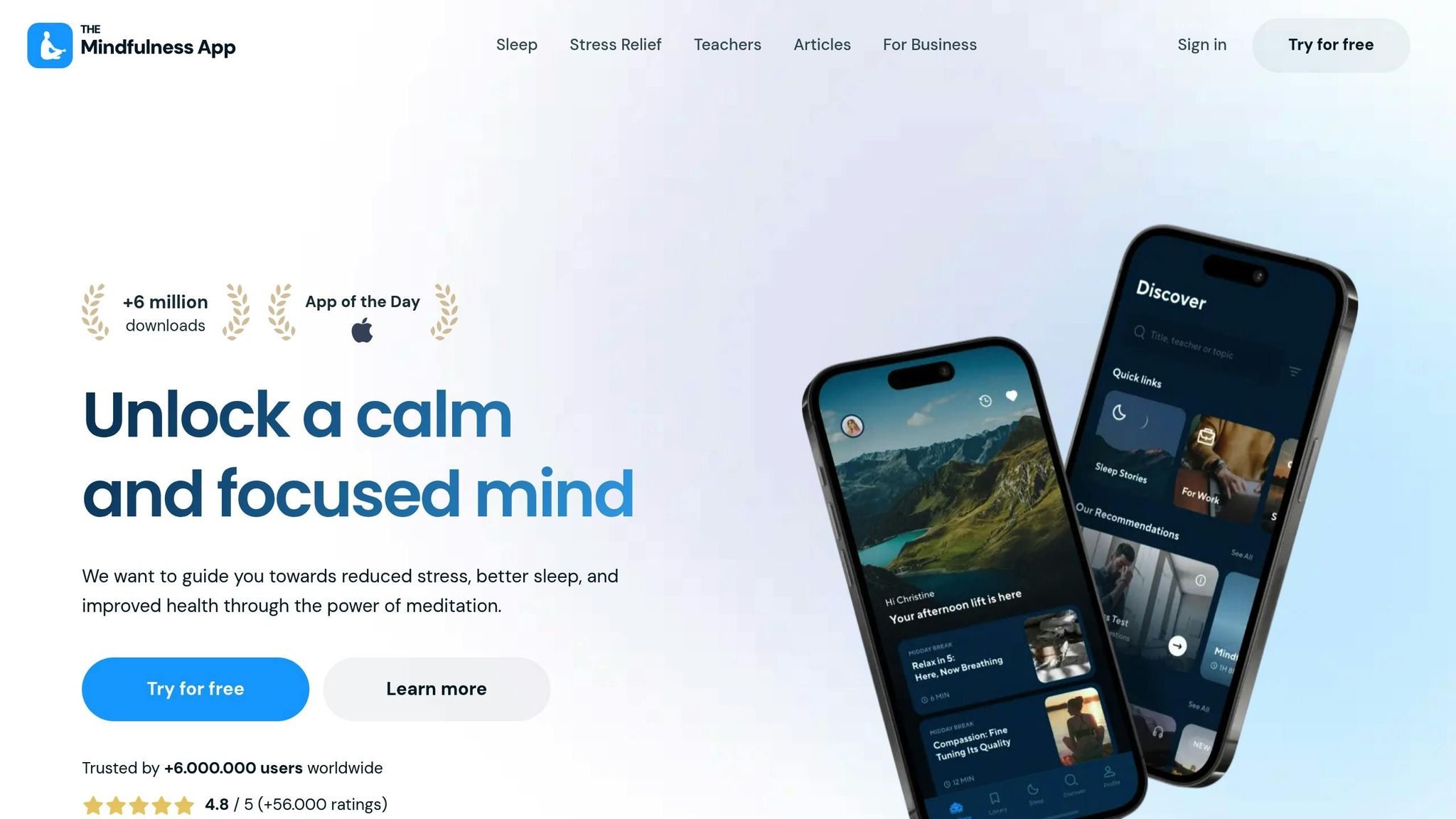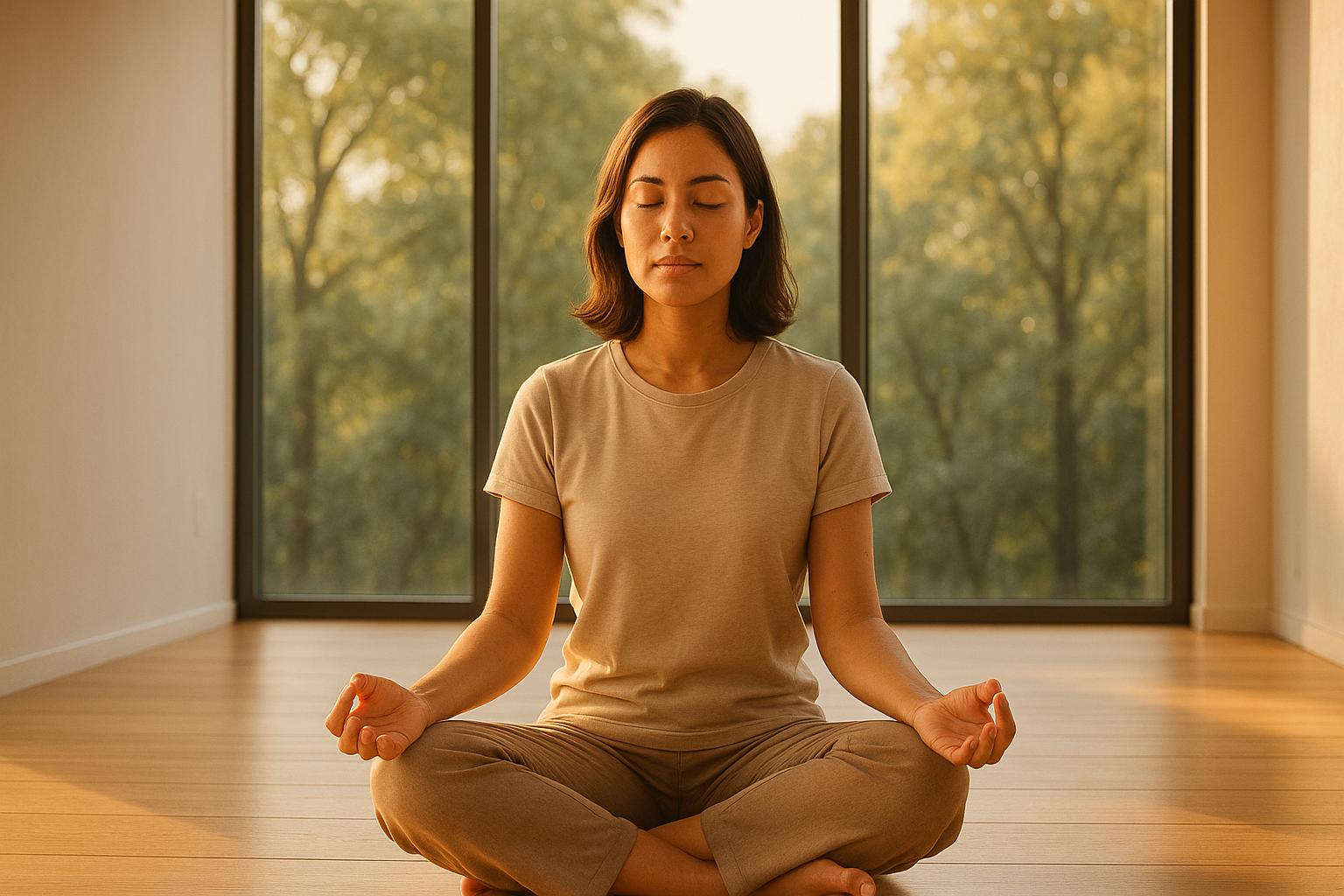When life throws changes your way - be it a new job, a move, or unexpected challenges - stress and uncertainty are normal reactions. But mindfulness can help you stay grounded and calm. By focusing on the present, you can reduce stress, handle emotions better, and feel more in control. Here’s a quick breakdown of how mindfulness can support you through life’s shifts:
- Stay present: Focus on the "now" instead of worrying about the past or future.
- Breathe intentionally: Simple breathing exercises like 4-7-8 or box breathing can ease tension.
- Body awareness: Practices like body scans help release physical stress.
- Be kind to yourself: Replace self-criticism with supportive, compassionate thoughts.
- Gratitude journaling: Write down three things you’re thankful for each day to shift your perspective.
Even small, consistent mindfulness habits - like taking 5 minutes to breathe or focusing on your steps while walking - can make a big difference. Tools like The Mindfulness App offer guided exercises and plans tailored to your needs, helping you integrate mindfulness into daily life. Start small, stay consistent, and let mindfulness guide you through life’s twists and turns.
15-Minute Meditation for Navigating Change | Embrace Change with Mindfulness & Calm
When Life Changes
Life changes often bring hard tests that can make even simple day-to-day things seem too big to handle. We will look into how being aware and careful can help in the parts that follow.
Feeling and Thinking Troubles
Feelings of fear and worry are normal when big life shifts happen. Not knowing what will come next can start endless "what if" thoughts, making calm sleep hard to get. Studies show that people with deep sadness are 2.5–9.4 times more likely to have gone through a big life event before feeling very low for the first time.. There's a strong link between big life changes and feeling mentally low.
Fear of the new can lead to ongoing stress and self-doubt, turning into "change fear", the bad feels too big over any good. The need to keep making choices, big or small, can wear you out.
Another layer of tough feelings comes from changes in who you are. If your part in life shifts - like starting a new job, moving or reaching a personal goal - you might feel like you are losing a part of who you were. These changes can make emotions harder, more so when your day-to-body, is shaken up.
Losing Daily Flow and Calm
Habits and routines make us feel safe and sure, but changes often mess these up. Losing this flow can make you feel lost, hurting the calm we get from our normal day-to-day.
For instance, moving to a new place means learning new streets, finding new shops, and making new friends - all of this can make stress worse. Even good things, like a better job, can shake your calm as you learn what's expected of you.
How It Affects Doing Things and Feeling Good
Handling many changes can mess with your focus and attention. The mental load of adapting can make you feel all over the place and less good at things.
At work, this might look like missing deadlines, having a hard time deciding things, or just not doing as well. Studies also link thinking of the worst outcomes with feeling less happy when life is shifting.
Stress from changes isn't just in your head; it can affect your body too. Usual body troubles include headaches, tummy issues, eating less or more, and not sleeping well. These problems can mess up how you get along with people close to you, making you feel alone or arguing more.
Money stress also often comes with life changes. Whether it’s not having a job for a while, costs of moving, or other big events, money troubles can make everything feel harder.
Ways to Stay Calm When Things Shift
When unexpected events hit, knowing some easy tricks can really help. Mindfulness tools offer easy, strong ways to keep your cool when life moves fast.
Stay in the Now
Paying attention to the now means you look at what's happening right here, not lost in past mistakes or future fears. Studies have found that this focus can cut stress, soothe nerves and sad feelings, and even lift your mood. The great part? These ups can stick around for days after the stress drops.
To get into this, take 5–10 minutes each day in a calm spot. Sit easy and watch your breath. When thoughts about job shifts, big moves, or new relationship stuff come up, note them without blame and turn your focus back to your breath. This easy task can make you stronger with time.
Breathing with Care
Your own breath is a ready tool to face stress - it’s always there, no matter what. Breathing with care can calm your nerves and keep you still when you feel too much.
Test the 4-7-8 breath method in tense times: breathe in through your nose for 4 counts, hold it for 7 counts, and blow out through your mouth for 8 counts. You can try box breathing too: breathe in for 4 counts, hold for 4, breathe out for 4, and hold for 4 counts - think of drawing a box in the air with each breath.
For daily use, belly breathing is top. Put one hand on your chest and the other on your belly. Take deep breaths so your belly hand lifts more than your chest hand. You can also do body checks all day. Stop, look at your shoulders, jaw, and belly, and take deep breaths to relax those spots.
Body Scan Meditation
Stressful changes can make your body tense - like tight shoulders, a hard jaw, or belly knots. Body scan meditation helps you find and ease that tightness before it grows.
Start at your head top and move your focus down slow, touching on each body part without trying to change it. If you feel tight - say, a stiff neck from job talk stress, or hip pain from moving worries - breathe into that spot and picture the tightness fading.
Kindness to Self
Change can make your inner critic loud - it tells you you're not doing well or fast enough. Kindness to self practices quiet that harsh voice and push you to treat you like you would a good friend.
When you start blaming yourself, pause and switch it up. Ask, "What would I say to a friend right now?" Then tell those kind words to yourself.
You can also take a self-kindness break when you feel too much. Start by saying: "This is a hard time." Then tell yourself that tough times are part of being human: "Hard times come to all." Last, be kind to yourself: "Let me be soft with me now."
Happy Notes
When times are unsure, writing down good things can turn your look to what’s still fine and strong in life. This act helps grow joy and makes you better at dealing with shifts.
Every day, write down three things you’re glad for. These small thankful bits can be like firm spots in wild times. Be clear. Not just "I’m glad for my family", but maybe "I’m glad my sister rang me today." Clear facts make it mean more and help you think back on those times better.
You might also pen thank you notes to folks who’ve helped you - even if you keep them. Saying thanks to others can turn your mind from the bad to the good in your world. Another way is to start a "change happy note book" where you list all good things from changes, like getting back in touch with an old mate or picking up a new fun thing. Seeing the bright side doesn’t wipe out your hard times; it just lets you view the whole scene.
These calm ways can slip into your daily life, giving you easy ways to go through life's shifts with peace and clear thought.
sbb-itb-bea8dce
Making Daily Mindfulness Habits
Putting mindfulness into your day can be as easy as cleaning your teeth. When these habits become a part of your day, they give a firm base to lean on, even when life throws curveballs.
Start Small with Daily Actions
Begin with just 5-10 minutes each day and build it up slowly. Research shows that regular practice - even a few times a week - can lower the chance of falling back into depression. The main thing is to keep it steady. Even short, done over and over, can make big changes felt.
Start with one easy thing. For example, take three deep breaths right after you wake up or check in with your body before you eat lunch. When this gets easy, which often happens in a week or two, put in another small habit. This slow step way lets you get into mindfulness without a rush.
It's very common for your mind to drift at the beginning. In fact, a study showed that 56.6% of people fell asleep while doing mindfulness sessions, mostly during body checks (57.8%). Interestingly, 67.6% of them took this in stride without being too hard on themselves, and some even said it helped them sleep better. Lots saw mindfulness as calming (64.1%), fun (50.5%), and pulling them in (49%) once they found their flow. Over time, you'll likely see your experience get better too.
These small steps can help, turning day-to-day moments into chances to be mindful.
Using Hints and Reminders
One of the simplest ways to keep up with mindfulness is to connect it to things you do every day. Begin your day by deciding to be mindful at key times - like when your phone rings. Turn interruptions into chances to pause. For instance, when your phone goes off, stop a moment, take a deep breath, feel your body, then act. A small break like this can change a busy moment into a cool and calm one.
"Mindfulness isn't difficult. We just need to remember to do it." – Sharon Salzberg, Insight Meditation teacher
Tech can be a good friend too. Use soft reminders during the day to check in on how you feel. Daily tasks can also be cues to be more aware. For instance, when brushing your teeth, focus fully. Feel the bristles and taste the toothpaste. Take a deep breath when you wash your hands, or focus on each step when you walk to the mailbox. These little, planned moments can help change how you deal with stress.
Even alerts on your phone can be cues to be mindful. For example, when you see "fully charged" on your screen, it can remind you to stay in the moment. A "missed call" alert might make you see when your thoughts drift - and that’s fine. Just bring your focus back to now.
Keeping Track with Ease
As you keep these habits, think about noting your mindfulness times. A fast note on your calendar or phone can show you patterns and help you see your growth. The aim isn't to be perfect - it's about being more aware.
Life changes, and so do routines. Maybe your usual 7:00 AM meditation doesn't work anymore due to a new job or family needs. At these times, simple mindfulness acts - like focusing on your breath while in line - can be very useful. Studies show these easy acts link to better wellbeing and more mental flexibility.
If you skip a few days, don’t be tough on yourself. Be kind to yourself like you would be to a friend. Instead of stopping the habit, start again when you can. Maybe take three mindful breaths before your morning coffee or enjoy the warmth of the water during your evening shower.
Notice what works best for you - whether they lower work stress or help your sleep - and change as needed. This constant self-awareness lets your mindfulness habits grow with you, giving you stability and strength amid life’s shifts.
Using The Mindfulness App as a Tool

The Mindfulness App gives you handy tools to help build and keep good mindfulness habits, and supports you as you face life’s highs and lows. It turns mindfulness ideas into real actions you can add to your day.
What’s in The Mindfulness App
With over 500 special tracks, The Mindfulness App aids you through different hard spots, like work stress, changes in relationships, or big life changes. The app has guided meditations, sleep tales, and mindfulness classes to help cut stress, better sleep, and boost overall health. It’s out in 12 tongues, so you can use it in the tongue that suits you best. Plus, its offline tool lets you keep sessions to use when you want, no matter where you are.
Made-for-You Meditation Plans
The app shapes meditation plans to fit your specific needs and times. If you're changing jobs, moving, or facing big shifts, you’ll find plans made to ease stress and bring peace. If curious about extra features, the app lets you try them free for 14 days, with full access to lots of mindfulness classes at no cost. This tailoring makes sure you have what you need to tackle life’s tough moments well.
Using It When Life Changes
Life changes often mean you need different ways to stay mindful. For example, if it’s hard to sleep, the app’s sleep tales can calm your mind. Starting fresh? The mindfulness classes offer clear, step-by-step advice you can step through at your speed. And with choices from short 5-minute breath exercises to longer body scans, there’s something to fit into your day, no matter how full or wild it gets.
Conclusion: Managing Change with Mindfulness
Navigating life’s transitions doesn’t have to feel overwhelming when you approach them with the right mindset and tools. Mindfulness serves as a steady anchor during uncertain times, helping you stay grounded while everything around you shifts.
By focusing on mindfulness techniques, you can train your mind to step away from worries about the future or regrets about the past. Redirecting your attention to the present moment creates the space you need to respond thoughtfully, rather than reacting on impulse.
Incorporating mindfulness into your life doesn’t mean upending your entire routine. Start small - just five minutes a day can make a difference. What matters most is consistency, not perfection. Some days, your practice may feel smooth and natural; on others, even a few moments of focus might feel like a challenge. That’s okay - what counts is showing up.
To make this journey even easier, practical tools like The Mindfulness App can provide structured support. With features like guided meditations, sleep stories, and courses available in multiple languages, this app helps integrate mindfulness into your daily life. Whether you’re navigating a career change, a relationship shift, or any other life transition, having resources like these at your fingertips ensures you can maintain your practice, even when things get complicated.
FAQs
How can I practice mindfulness even with a busy schedule?
Incorporating mindfulness into your busy day might be simpler than you think. Start small with practices like mindful breathing or a quick body scan - both take just 3 to 5 minutes. You can fit these into your day during a commute, a coffee break, or even while waiting in line.
Another easy way to practice mindfulness is by tuning into your senses. Pay attention to the taste of your food during meals or notice the sensation of water on your hands while washing up. A three-breath reset or grounding exercises can also help you refocus and stay present, even on hectic days.
The secret is making mindfulness a regular part of your routine. These small, simple practices can ease stress, sharpen your focus, and help you feel more grounded - all without requiring extra time out of your day.
What are some mindfulness techniques to help manage anxiety during major life changes?
Mindfulness offers a practical way to navigate anxiety during major life changes. Simple practices like deep breathing exercises, such as the 4-7-8 technique, can help ease your mind and body by centering your attention on your breath. Another helpful option is body scan meditation, which involves focusing on different areas of your body to release built-up tension.
You could also explore mindful walking, a practice that keeps you grounded by concentrating on each step and the sensations in your surroundings. For a quick way to regain focus, the 5-4-3-2-1 grounding exercise engages your senses to bring you back to the present moment. These mindfulness techniques can help you feel more relaxed, reduce stress, and maintain emotional balance during times of transition.
How can mindfulness help reduce the physical effects of stress?
Mindfulness is a powerful tool for soothing the physical toll stress takes on the body and mind. By practicing mindfulness, you can reduce stress-related markers like blood pressure, heart rate, and cortisol levels - factors that often spike during times of high stress.
Techniques such as deep breathing, body scans, and guided imagery promote relaxation, helping to ease physical discomforts like muscle tension, fatigue, and even pain. Over time, these practices not only support better physical health but also contribute to a greater sense of calm and balance in your daily life.






